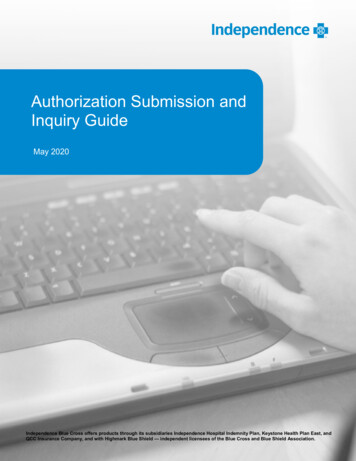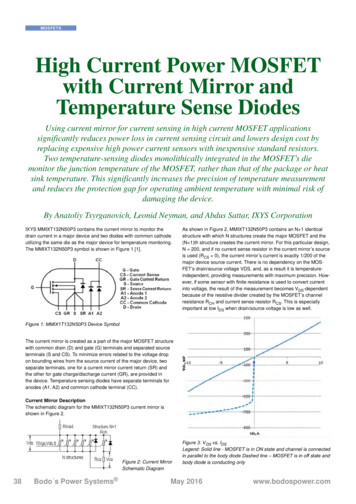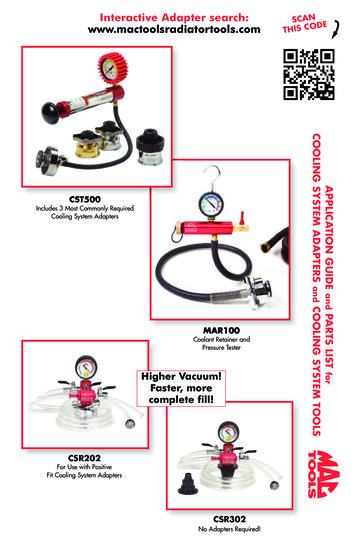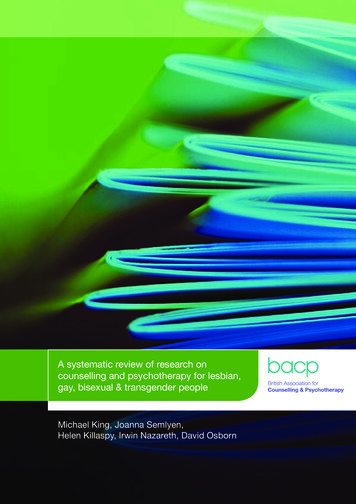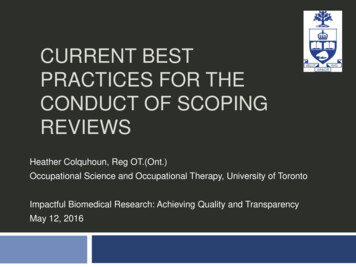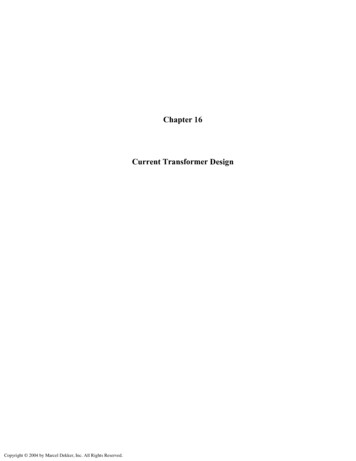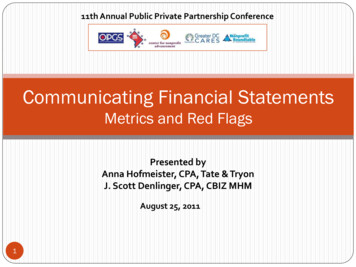
Transcription
the Institutefor EmploymentStudiesA Review ofCurrent Research intoAbsence ManagementDarcy HillSue Hayday
Published by:THE INSTITUTE FOR EMPLOYMENT STUDIESMantell BuildingFalmerBrighton BN1 9RFUKTel. 44 (0) 1273 686751Fax 44 (0) 1273 690430http://www.employment-studies.co.ukCopyright 2003 The Institute for Employment StudiesNo part of this publication may be reproduced or used in any form by any means—graphic,electronic or mechanical including photocopying, recording, taping or information storage orretrieval systems—without prior permission in writing from the Institute for EmploymentStudies.
1. IntroductionThis report reviews the most recent findings in absence statisticsand attendance management. This will serve as a resource forresearchers and HR managers attempting to understand what canbe done to improve attendance management, and also to compareand contrast the various absence statistics amongst differentbusiness types, and job functions.1.1 StructureBuilding on the model set out by Silcox and Ballard in their report‘Sickness Absence -The Background Statistics’ (1998), this review willupdate the findings on absence and attendance management, anddiscuss general developments in each of the surveys included inthe original. The reports and surveys summarised in this revieware:z THE CBI Annual absence and labour turnover survey (2002)z THE CIPD Employee Absence (2002)z The Work Foundation ‘Maximising Attendance’ (2002)z Norwich Union’sHealthcare (2001)Managingz Sickness Absence inOrganisation rsz Analysis of Sickness Absence in the Civil Service, CabinetOffice (2001)z Social Services Sickness Absence ManagementEmployers Organisation (Summer 2002)Report,A summary of the findings from these reports and surveys can befound in the Appendix at the end of this report.A brief description of the methodology used, and the nature of thedata will be used to introduce each survey summary. This willthen go on to provide the relevant absence data, and discuss themanagement practices and policies which have been employed,and/or recommended. Finally, the review of each survey willprovide some overall conclusions combining the findings aboutabsence data and attendance management policies.A Review of Current Research into Absence Management3
1.2 Measuring absenceThe methodologies used by the surveys reviewed in this report,vary as widely as the methodologies employed by organisationsthemselves. The collection and analysis of absence data, whereconducted, differs considerably in three main ways:z nature (the variables examined)z quality (method of data collection and compilation)z reliability (the accuracy of given indicators to portray a givensubject).Absence itself can be measured in many different ways. Mostorganisations use the number of days lost, either as a direct figure,or in relation to the total number of working days per year, toproduce a percentage. In order to relate the impact of long-termversus short-term absence, other methods are employed such asthe ‘Time Lost’ measure, and the ‘Bradford Factor’.While ‘Time Lost’ measures the percentage of shifts workedagainst those available, the ‘Bradford Factor’ weights absence toreflect the number of spells taken (which more accurately reflectsthe balance between long-term and short-term absence). The‘Bradford Factor’ is calculated using the following formula:Absence D (S S), where D total days absence over a setperiod, and S spells of absence over the same period.The collection of absence data, and the methods employed, alsoimpacts on the findings. When researching the causes of absence,for example, various elements have the potential to completelyalter the outcomes:z who is being asked: is it the employee, the manager, or theGP?z how are they being asked: is it cause as stated on a certificate,an option from a list of possibilities, are managers being askedto recall particular causes of absence, or to generalise allabsence causes?z how many have responded: in larger surveys that looked atcauses, not all respondents were able to provide theappropriate data, which results in a small sample and aninaccurate representation of the overall group.Also important to note, is that when increased efforts are made toaccurately record absence data (particularly in combination withfocused absence management strategies), absence rates aresometimes seen to increase. As the quality of reporting andrecording improves, fewer absences go unreported, which resultsin an increase on previous absence records. When more stringentrecording is combined with attendance management strategies,however, this increase should subside.4The Institute for Employment Studies
2. Annual Absence and Labour Turnover Survey(CBI)This report summarises the findings of the fifteenth annual surveyof absence and labour turnover conducted by the Confederationof British Industry (CBI), with the first survey being conducted in1987. It collected data between January and February of 2002,which reflected on the time period between January 1 andDecember 31 of 2001. For the purposes of this report, only theinformation regarding absence will be reviewed here.2.1 MethodologyThe CBI attempted to gather a representative sample of privateand public industry and business in their survey of 746organisations. The survey completed by senior managers and HRprofessionals represents a total of 2.3 million employees(approximately 9 per cent of the UK’s total workforce). It includesorganisations from all regions of the UK, from all industry sectors,and covers organisations of all sizes. In this way they aimed tocreate an accurate picture of absence and labour turnover in theUK. The CBI also reminded readers that there was considerablevariation between these variables, and that employers using thedata to benchmark their own performance were best to use onlythose organisations with similar profiles (size, industry type,region etc.).2.2 AbsenceIn regards to time lost through absence, the CBI found the lowestabsence rates ever, since starting the survey in 1987, with anaverage of 7.1 days lost per employee. Within this figure,however, their was a difference between manual and non-manualabsence rates, with manual employees averaging 8.8 days andnon-manual employees averaging 5.5 days per year. The CBIobserved that this difference has varied over the last fifteen years,with the gap closing steadily up to 1998 (where it reached 1.8 daysdifference), it has since been on the rise despite decreases inaverage absence in both groups (in 2001, and in the previous threeyears).A Review of Current Research into Absence Management5
The CBI report found that absence rates were highest amongstpublic sector employees, with 10.1 days lost per employee onaverage, compared to 6.7 days across the private sector. This gapbetween the public and private sectors has been steadilyincreasing over the last few years. There has also been a steadyincrease in the difference between the best and worst performerswithin the private sector. Within the private sector, transport andcommunication had the highest absence rates, while IT/hi-techservices had the lowest absence rates.The CBI, as with other surveys of this nature (Bevan and Hayday,2001), found a correlation between workplace absence andcompany size, in that the larger the company was found to be, themore days were lost to absence (on average per employee). TheCBI’s analysis attributes this difference to the increased peerpressure and greater involvement in absence management bysenior managers found in smaller organisations, both of whichhave been shown to have a positive impact on reducing absence.While there was no correlation found between regions andabsence rates, there was a certain amount of variance. In 2001,absence rates were highest in Northern Ireland (9.1 days peremployee), the Northwest (8.5 days), and Yorkshire andHumberside (8.4 days). The lowest absence rates were in theregions of Greater London (6.4 days), the Southeast (6.0 days), andthe Southern region (5.1 days).2.3 Rising costs of absenceThe CBI’s survey queried both the direct and indirect costs ofabsence, by way of estimation and calculation. Direct costs werebased on the salary costs of absent individuals, replacement costs,and lost service or production time. Indirect costs, wherecalculated (only 9 per cent of companies were found to monitorindirect costs) were based on lower customer satisfaction andpoorer quality of service or products, leading to the loss of futurebusiness.The median costs of absence were:z direct costs 476 per employeez indirect costs 222 per employee.The direct costs had risen from the previous year’s cost of 434 peremployee, marking the first reversal of an otherwise downwardtrend in direct absence costs. Only a small number of companieswere able to provide an estimate of indirect costs, so the figuresabove must be treated with caution.Absence costs between private and public sectors were found tovary considerably, with private sector absence costs beingtraditionally lower, despite a slight increase in 2001. While6The Institute for Employment Studies
absence costs rose in both sectors (from 432 to 474 in the privatesector, and from 482 to 518 in the public sector), the gapbetween the public and private has narrowed (from 50 to 44).The 2001 CBI survey introduced a new question to their research,asking respondents whether they have examined the relationshipbetween employees’ health when they are at work and theirperformance. While most had not considered this, amongst thesmall group of those who did, 66 per cent found a strongcorrelation between employees’ state of health and theirperformance in work.2.4 Causes and curesIn regards to causes of absence, the CBI 2001 survey found thefollowing:z as compared to previous survey results, there was markedincrease in the number of companies that monitored andcollected data on the causes of absence in their organisationsz going by employers’ perception of the causes of absence,general illness was found to be the most prevalent reason forboth manual and non-manual employeesz however, the second most prevalent perceived cause ofabsence amongst manual employees was ‘paid sickness seenas entitlement/unauthorised holidays’z under the heading ‘general illness’, minor short-term illnesswas the most prevalent in both manual and non-manualemployee groups. However, recurring illness and seriouslong-term illness were considered second and third mostfrequent amongst manual employees, and stress was seen tobe the second most prevalent cause of absence within the nonmanual employee group.z while the majority of absence spells were due to short-termabsence (less than 20 days, 95 per cent) a significantproportion of working days were lost to long-term absence(more than 20 days, 31 per cent).In addition to assessing absence rates, the CBI survey also reportson the state of attendance management. Amongst theorganisations surveyed, it was found that line managers tendedmost frequently to be responsible for absence management (73 percent). It was also found, however, that only 51 per cent of thesemanagers received (or were offered) any absence-related training.When examining the relationship between absence managementand absence rates, an interesting observation was made. Inparticular, it was found that those organisations that had seniormanagers responsible for managing attendance had the lowestabsence rates. Similarly, absence rates were highest were lineA Review of Current Research into Absence Management7
managers were responsible for managing attendance. The gap inabsence rates between these two types of organisational structuresresulted in a difference of just over two days on average, peremployee.Respondents were asked to select from a range of possible optionsthe absence management tools which were used in theirorganisation, and to indicate how effective they perceived each tobe. The most frequently used tools included (in descending orderof frequency):z return to work interviewsz discipline proceduresz providing supervisors with absence statisticsz formal notification procedures.A similar list results from those tools perceived as being mostefficient in managing absence, but with ‘formal notificationprocedures’ taking third place above ‘providing supervisors withabsence statistics’. However, just as the absence rates variedbetween manual and non-manual employees, so did theeffectiveness of different absence management approaches varybetween the two groups of employees. The CBI recommends thatemployers take time to consider tailoring policies to the needs ofthe workforce.Rehabilitation policies were found to be utilised mostly by largerorganisations; however, in total 48 per cent of those surveyed hadmade arrangements for the rehabilitation of employees. Also, itwas found that 93 per cent of organisations had implementedtransitional working arrangements for employees returning towork from absence, and 80 per cent had introduced counsellingsupport.2.5 ConclusionsWhile overall absence rates fell, major differences still existbetween manual and non-manual employee groups, in addition todifference between private and public sector absence rates. Also,while absence rates declined, the costs of absence had risen forboth the private and public sectors. Absence management wasfound to be mostly the responsibility of line managers; however, itwas most effectively administered by senior managers, therebyresulting in lower absence rates.8The Institute for Employment Studies
3. ‘Employee Absence in 2002: A Survey ofmanagement policy and practice’ (CIPD)This report summarises the results of the Chartered Institute ofPersonnel and Development’s (CIPD) third survey of this kind,examining the rates and costs of sickness absence in the UK. Thisyear’s report had the further aim of highlighting absencemanagement approaches which have been proven successful inreducing overall absence, and particularly long-term absence.3.1 MethodologyThe survey was conducted in February 2002, amongst a randomlyselected sample of 7,000 people management specialists. Thissample received questionnaires that contained twenty-fivequestions pertaining to absence levels, costs, and causes, as well asmethods and practices for managing sickness absence.The survey achieved a response rate of 17.5 per cent, equal to1,312 successful replies. The CIPD calculated that their samplerepresented approximately 1.7 million employees, or 6.2 per centof the total UK workforce (based on figures from the Labour ForceSurvey, 2002).Organisations were categorised by industry sector (manufacturingand production, private sector services, public services, and notfor-profit), and by specific business area. In addition, companieswere categorised by workforce size.3.2 Absence ratesThis survey found an overall absence rate of 4.4 per cent ofworking time, equivalent to ten working days per employee(based on a working year of 228 days). However, this figurerepresents only 1,095 organisations, as 15 per cent of thosesurveyed did not collect sickness absence data in theirorganisations. It was found that organisations in the public sectorwere more likely to collect absence data (90 per cent) than those inthe private sector, in which 23.5 per cent did not do so.A Review of Current Research into Absence Management9
3.2.1 Changes in absence ratesWhile 2002’s overall absence rate marks an increase on the ratesfor 2000 and 2001 (3.8 per cent), the highest levels of absenceremained in the same industry sectors, such as particular parts ofmanufacturing (food, drink, and tobacco) and among public sectoremployees. The survey analysts do suggest that their estimate ofoverall absence may be exaggerated by their large representationof major employers (42 per cent of the sample have 500 or moreemployees). This is supported by their finding that amongbusiness with 100 employees or less, there was an overall absencerate of 3.7 per cent (compared to a 4.7 per cent absence in businessof 2,000 ). In terms of region, the Southeast was found to havelower than average absence (3.6 per cent), and organisations inWales and the Northeast were higher than average (5.1 per centand 5.0 per cent respectively).The rise in the overall absence rate also conflicts with peoplemanagement professionals’ own estimation of increases ordecreases in absence levels. 41 per cent believed that absence haddecreased in the last two years, 31 per cent believed it hadremained the same, and 28 per cent felt that absence had risen (23per cent were unable to answer this question). Increases inabsence levels were associated with changes in recording absencedata, and changes in workload. Conversely, decreases in absencewere associated with tightened policies for reviewing attendance,in addition to changes in recording absence.By asking respondents to estimate the proportions of absence byduration (65 per cent of whom were able to respond), the CIPDsurvey was able to determine that 57 per cent of all absence ismade up of short-term spells (absence less than five days). Afurther 19 per cent of absence is made up of five days to fourweeks, and 18 per cent of four weeks or longer.3.2.2 Costs of AbsenceJust under half of the organisations surveyed monitor the cost ofsickness absence (48 per cent). However, this varied considerablybetween industry sectors:z 56 per cent of manufacturing and productionz 46 per cent of service sector employersz 36 per cent of public sector.The factors taken into account when calculating costs of absencevary; however, most include occupational sick pay costs (79 percent), and/or statutory sick pay (72 per cent). Much fewer includethe costs of replacement labour (40 per cent), overtime costs (35per cent), or reduced performance (21 per cent), suggesting thatavailable absence costs may be considerably underestimated.10The Institute for Employment Studies
For those organisations calculating costs (31 per cent), the averagecost of absence is 522 per employee (an increase of 7 per centfrom 2001). Due to the small number of organisations calculatingcosts, a further analysis of costs by sector and workforce sizewould be unreliable.In order to gain an understanding of the impact of absence costson businesses, all respondents were asked to rate the significanceof absence on overall costs. This revealed that most employersperceived the cost of absence as significant (66 per cent), or verysignificant (25 per cent). Only five per cent considered the costinsignificant. Although there was little variance between sectors,the size of workforce did seem to affect perception, with smallerorganisations tending to be less concerned: 40 per cent of thoseemploying 100 or less said costs were insignificant, compared totwo per cent of organisations that employed 2,000 or more, takingthe same view.3.3 Causes of sickness absenceAcross all sectors, 79 per cent of organisations surveyed collectdata regarding the cause of absence. The most common cause ofabsence for all types of employees (including short-term and longterm absences) is minor illnesses such as colds or flu. Absences offour weeks and over are more likely to be due to stress amongnon-manual staff, and back pain amongst manual staff.Long-term absence as a result of stress was not only correlated tonon-manual employees, but was also more likely in largeorganisations (68 per cent in organisations of 2,000 employeesversus 33 per cent in organisations with less than 100 employees),and in public sector organisations (64 per cent in public sectorversus 30 per cent in manufacturing and production).3.4 Attendance managementMost organisations surveyed have a sickness management policy;however, this was more likely in large organisations (94 per centwith 2,000 employees) than in smaller organisations (74 percent). Public sector employers were also more likely to havepolicies (94 per cent) than manufacturing (82 per cent) and privatesector services (78 per cent).Many of the organisations also had specific long-term absencemanagement strategies (89 per cent). These strategies includedproviding sickness absence information to line managers, havingabsence triggers and involving occupational health professionals.The most effective approach to managing long-term absence wasmaintaining regular contact with the employee, in combinationwith referral to the occupational health department.A Review of Current Research into Absence Management11
Helping employees return from long-term absence was managedin a variety of ways, the most frequent being the use of return-towork interviews (82 per cent) and maintaining regular contactwith employees during absence (90 per cent). The take-up ofthese, and all other methods, was more frequent in the publicsector than any other.Finally, it was found that most organisations (62 per cent) do notbenchmark their absence management performance against that ofother organisations, although public sector organisations weremore likely to do this. Encouragingly, it was found that over halfof employers surveyed (57 per cent) had made changes to theirabsence management policies in the last two years. Some of thesechanges included complete revisions (25 per cent), the addition ofreturn-to-work interviews (22 per cent), or the introduction offollow-up, review or monitoring procedures (21 per cent).12The Institute for Employment Studies
4. ‘Managing Best Practice: MaximisingAttendance’ (The Work Foundation)The Work Foundation (TWF) report compiles the data gathered inthree research segments: a survey of human resource specialistsdrawn from the Foundation’s database, a case study summary(covering six organisations), and consultancy advice based on theresearch findings of the survey and the case studies. For thepurposes of this review, only the results of the survey will beexamined in detail, while the case studies and consultancysections will be referred to only briefly.4.1 MethodologyThe survey was carried out in April 2002, and had 403respondents. It gathered information about absence rates, thecosts of absence, and management strategies employed to helpreduce absenteeism. The respondents, who were randomlyselected (representing a 7 per cent response rate), broadly reflectthe distribution of regions, sector areas, and company size fromthe population in general. However, this is not representative.Included in the report are the summaries of six case studies whichwere conducted with organisations varying in industry, region,and size. The case studies examine the organisations’backgrounds, looks at their aims in attendance management, andthen reviews their strategy and practice, making note of areas forpotential improvement.Finally, the consultancy section reports (in question and answerformat) on an interview conducted with Stephen Bevan, aboutbest practice in attendance management.4.2 Absence ratesThe Work Foundation found that for the first time since 1996,absence rates had increased to an overall absence rate of 4.1 percent of total working days. This is a difference of 1.2 per cent from2001’s rate of 2.9 per cent.A Review of Current Research into Absence Management13
This overall figure conceals differences between various companycharacteristics, and employee subgroups. For example, the surveyfound the greatest difference between private andpublic/voluntary sectors, with the former having the highestabsence rates of all and the most dramatic increase (moving from3.0 per cent in 2001, to 7.9 per cent in 2002). Manufacturing,Utilities, Financial, and Services all had slight decreases (Utilitiesdecreasing the most, from 3.4 per cent in 2001 to 1.5 per cent in2002).Manual workers and females have both traditionally had higherabsence rates; however, this survey’s findings showed that neithergroup had higher than average absence (despite females havingincreased slightly over the previous year’s rates). This findingshould be treated with extreme caution, however, as only ten percent of survey respondents were able to provide a breakdown ofthe absence rates by gender, employee subgroup, and fulltime/part-time status.An analysis of absence by region shows that Scotland andNorthern England both experienced considerable increases inabsence for 2002: Scotland having a rate of 5.7 per cent increasingby 2.7 percentage points, and North of England with 10.8increasing 6.6 percentage points. Other areas, such as GreaterLondon, the South and Southeast England, and CentralEngland/East Anglia, all experienced slight rises in the absencerates. Wales and the Southwest experienced slight decreases intheir rates.The size of organisation has also traditionally been seen toinfluence absence rates, in the way of larger organisations tendingto have higher absence rates. The Work Foundation’s results,however, did not indicate this relationship in such a directmanner: while the smallest companies did have the lowest rates(under 100 employees, 2.4 per cent), the second smallest group ofcompanies had the highest absence rates (101 to 500 employees,5.1 per cent). This compares to the largest organisations (over2,500 employees) having a average absence rate of 3.5 per cent.Again, these results may not be representative, due to the smallsample size (403 organisations).4.3 Causes of absenceThis survey examined the main causes of absence from both theperspectives of employers and employees: the former as recordedon self-certification forms, and the latter in the opinion of themanagers. While this approach poses various methodologicaldifficulties, it does provide an interesting picture of whatmanagers perceive as being the real reasons for absence.According to Employees self-certification forms, the top fivecauses of absence are: cold and flu (94%), stomach upsets or food14The Institute for Employment Studies
poisoning (77%), headaches or migraines (64%), stress oremotional/personal problems (54%), and back problems (47%). Inthe opinion of managers, however, only two of these causes madeit to their top five causes of absence: cold and flu (59%), stress oremotional/personal problems (58%), Monday morning blues orextending the weekend (39%), sickness of other family membersor childcare problems (36%), and concept of taking sick leaveentitlement (31%).This aspect of the survey highlighted various discrepanciesbetween employees’ self-proclaimed reasons for absence, andmanagers’ opinions of reasons for absence. In particular,managers’ opinions of job satisfaction-related absence were muchhigher than employees’ own admission. It should also be noted,however, that while the employees’ data for causes of absenceaccurately represents the claim for each case of absence, theopinions of managers represent a generalisation of all cases ofabsence.4.4 Recording and costing absenceThe Work Foundation surveyed managers about their recordingpractices for absence, and in particular, how well they felt thesepractices worked. For the most part, managers seemed quiteconfident that sickness absence was being recorded, with 76 percent feeling that 80 to 100 per cent of absences were beingrecorded. On average, managers felt that 86 per cent of absencewas being recorded. Only one per cent of managers said thatabsence was not recorded at all. This varied little between regions,industry sectors, and public and private sectors, however, theview did seem to be less prevalent in organisations with between1,001 and 2,500 employees.Despite the effort put towards measuring and recording absence,55 per cent of organisations did not measure the cost ofabsenteeism, and only 43 per cent did (which is nine per centfewer organisations than in 1996). Those organisations located inGreater London were found to be least likely to calculate the costof absence (27 per cent); however organisations with multiplelocations were equally unlikely to do the same (27 per cent). Othervariables exerted little influence on an organisations’ likelihood tocalculate costs.When asked why organisations did not calculate the cost ofabsenteeism, managers gave a variety of responses. The threemain reasons for not costing absence were:z too time-consuming (33 per cent)z no computerised personnel system (30 per cent)z no accurate attendance records (23 per cent).A Review of Current Research into Absence Management15
It was also noteworthy, however, that almost a quarter (23 percent) felt that absence was not a problem and the associated costwas therefore, not worth measuring. The lack of computerisedpersonnel systems posed the biggest barrier to small businesses;however, this group were also more likely to say that absence wasnot a problem (32 per cent). Also, it was London organisationsthat were most likely to say that costing absence was too timeconsuming (40 per cent).In regards to calculating the costs of absence, managers wereasked which factors were used, and which factors exerted costsbut were too difficult to calculate. Their responses indicated thatthe most common factors used in the calculation of absence costswere:z statutory sick pay (66 per cent)z occupational sick pay (68 per cent)z extra cost of temporary staff employed (58 per cent)z extra cost of overtime (47 per cent)z effect on productivity (26 per cent).The factors which were acknowledged by managers to exert costson absence, but were felt too difficult to calculate, included:z management time dealing with absence (47 per cent)z low morale of absentees’ colleagues (46 per cent)z effects on productivity (44 per cent)z effect on quality (43 per cent)z low morale or boring job (31 per cent).4.5 Managing attendance, and absence policyThe Work Foundation survey looked primarily at the use offlexible working policies, and then at their perceived usefulness inreducing absence. While this approach introduces the samedifficulties encountered when asking manag
Absence D (S S), where D total days absence over a set period, and S spells of absence over the same period. The collection of absence data, and the methods employed, also impacts on the findings. When researching the causes of absence, for example, various elements have the potential to completely alter the outcomes:

